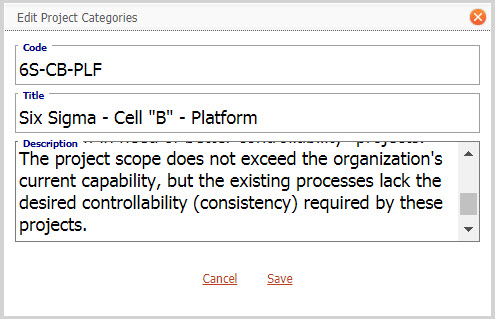Create and Manage Project Categories
Background
Process
1) Click Settings
2) Under Projects click Categories,
Click on picture to enlarge
3) Check the Category doesn’t exist by filtering grid on either code or title.
4) Add, edit, delete categories’s using the icon buttons identified below.
Click on picture to enlarge
Click on picture to enlarge
Pre-Requisite Requirements
Licensing – users are to be licensed for the ORG module, this can be found under Settings then click User Licensing , set a billing account for the user. For more info see Knowledge Base Article -> User Licensing
Roles – users are to be assigned a user role for accessing the Billing Classification menu item. This can be found under Settings – System Security then click Assign User Roles . For more info see Knowledge Base Article -> Assign User Roles
Categories do not require any other pages pre-populated with data prior to their use.
Additional Information
| Field | Example Input | Characters | Field Restrictions |
|---|---|---|---|
| Code | R&D-L1 | Min 1 Max 50 | Mandatory
Alpha, Numeric and special characters allowed. No Duplicates Allowed. |
| Title | Research & Development – L1 | Min 2 Max 200 | Mandatory
Alpha, Numeric and special characters allowed. No Duplicates Allowed. |
| Description | Low Risk | Min 2 Max 500 | Non Mandatory
Alpha, Numeric and special characters allowed. |
| Code | Title | Description |
|---|---|---|
| CON-CAT1 | Construction Category 1 | < $500k Contract Type 1 No-design responsibility or minor design element only. (Asphalt mix design, services co-ordination etc.) Risk = base |
| CON-CAT2 | Construction Category 2 | $500k – $5m Design only using a standard proven design without performance guarantees OR Concept & pre-feasibility studies (services are non binding & will be superseded by final design) |
| CON-CAT3 | Construction Category 3 | $5m-$30m Design and construct responsibility using a standard & proven design without performance guarantees Risk = intermediate |
| CON-CAT4 | Construction Category 4 | $30m-$100m Contract Type 2 Design responsibility using a standard & proven design but includes performance guarantees (with or without construction) |
| CON-CAT5 | Construction Category 5 | >$100m Design responsibility using a new or unproven design with or without performance guarantees (with or without construction) OR Full EPC responsibility using a standard & proven design with performance guarantees |
| Code | Title | Description |
|---|---|---|
| R&D-L1 | Research & Development – L1 | Low Risk |
| R&D-L2 | Research & Development – L2 | High Risk |
| Code | Title | Description |
|---|---|---|
| 6S-CA-DER | Six Sigma – Cell “”A”” – Derivative | Good System Controllability Good System Capability www.pmi.org These projects require the least amount of change to the existing system. They can be categorized as “derivative” projects where the project scope requires only incremental change to the existing system offerings. The project scope does not exceed the organization’s current capability. Existing processes meet the desired controllability required by these projects. . |
| 6S-CB-PLF | Six Sigma – Cell “”B”” – Platform | Poor System Controllability Good System Capability www.pmi.org These projects require a substantial amount of change to the existing system. They can be categorized as “platform-in need of better controllability” projects. The project scope does not exceed the organization’s current capability, but the existing processes lack the desired controllability (consistency) required by these projects. |
| 6S-CC-PLF | Six Sigma – Cell “”C”” – Platform | Good System Controllability Poor System Capability www.pmi.org These projects require the most amount of change to the existing system. They can be categorized as “breakthrough” projects. Their project scope exceeds the organization’s current capability and the existing processes lack the desired controllability required by these projects. Projects that deal with completely new product/process development and reengineering projects. |
| 6S-CD-BRK | Six Sigma – Cell “”D”” – Breakthrough | Poor System Controllabillity Poor System Capability www.pmi.org These projects also require a substantial amount of change to the existing system. They can be categorized as a “platform-in need of better capability” project. Their project scope exceeds the organization’s current capability, but the existing processes meet the desired controllability required by these projects. Long-term, “stretch goal”-based Six Sigma improvement projects are good examples of projects in this category. |



